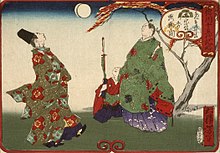Kemari




Kemari (蹴鞠) is an athletic game that was popular in
History
The earliest kemari was created under the influence of the
Kemari became popular as a game for the nobility in the late
It reached its peak between the end of the 12th century and around the 13th century in the early Kamakura period (1185–1333), and kemari games were often played during the reign of Minamoto no Yoriie. This led to the establishment of a variety of new rules, equipment and techniques, and the completion of a structured art form called kemaridō (蹴鞠道). In the Kamakura period, kemari became popular among the samurai class, and in the Muromachi period (1336–1573), kemari, along with various other performing arts such as waka (Japanese poetry) and the Japanese tea ceremony, was regarded as one of the art forms that the samurai class was encouraged to master.[1][4]
In the Sengoku period (1467–1615), sumo became popular and kemari declined, but in the Edo period (1683–1868) it became popular again as a game played by chōnin class in the Kinai (Kansai region).[1]
In the past, aristocrats living in
George H. W. Bush played the game on one of his presidential visits to Japan.[5][6]
Description
It is a non-competitive sport.[7] The object of Kemari is to keep one ball in the air,[2] with all players cooperating to do so. Players may use any body part with the exception of arms and hands: their head, feet, knees, back, and depending on the rules, elbows to keep the ball aloft. The ball, known as a mari, is made of deerskin with the hair facing inside and the hide on the outside. The ball is stuffed with barley grains to give it shape. When the hide has set in this shape, the grains are removed from the ball, and it is then sewn together using the skin of a horse. The one who kicks the ball is called a mariashi. A good mariashi makes it easy for the receiver to control the mari, and serves it with a soft touch to make it easy to keep the mari in the air.
Kemari is played on a flat ground, about 6–7 meters squared.[3] The uniforms that the modern players wear are reminiscent of the clothes of the Heian period and include a crow hat. This type of clothing was called kariginu (ja:狩衣) and it was fashionable at that time.
See also
References
- ^ a b c d e f 神社と深くつながる「蹴鞠」 (in Japanese). Kokugakuin University. Archived from the original on 5 December 2022. Retrieved 5 December 2022.
- ^ ISBN 9780977668809. Retrieved 2010-07-08.
- ^ ISBN 9780824824648. Retrieved 2010-07-08.
- Asahi Shimbun. Archived from the originalon 5 December 2022. Retrieved 5 December 2022.
- ^ Wines, Michael (1992-01-07). "On Japan Leg of Journey, Bush's Stakes Are High". The New York Times.
- ^ Wines, Michael (1992-01-08). "Japanese Visit, on the Surface: Jovial Bush, Friendly Crowds". The New York Times.
- ^ "History of Football". FIFA. Archived from the original on December 25, 2012. Retrieved 29 April 2013.
External links
![]() Media related to Kemari at Wikimedia Commons
Media related to Kemari at Wikimedia Commons

